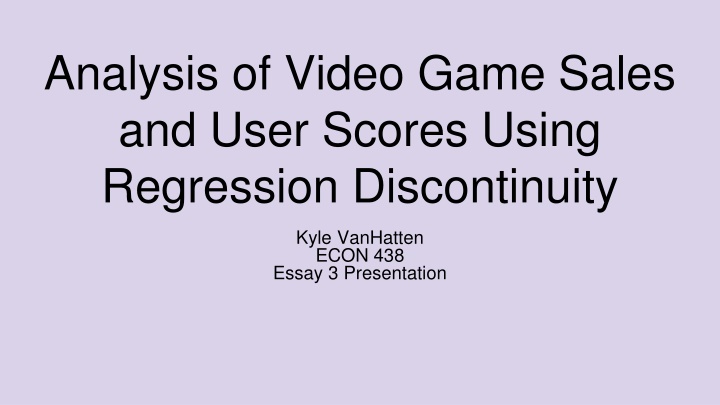
Exploring Video Game Sales & User Scores Through Regression Analysis
Discover the correlation between critic scores, user scores, and global sales using Regression Discontinuity Analysis. Unveil potential perception biases at key score thresholds and analyze the impact of critic reviews on user opinions. With insights on Metacritic review coloring, data cleaning, treatment variables categorization, and methodological approaches such as RD models and subset analysis, this study dives deep into the dynamics of video game evaluations.
Download Presentation

Please find below an Image/Link to download the presentation.
The content on the website is provided AS IS for your information and personal use only. It may not be sold, licensed, or shared on other websites without obtaining consent from the author. If you encounter any issues during the download, it is possible that the publisher has removed the file from their server.
You are allowed to download the files provided on this website for personal or commercial use, subject to the condition that they are used lawfully. All files are the property of their respective owners.
The content on the website is provided AS IS for your information and personal use only. It may not be sold, licensed, or shared on other websites without obtaining consent from the author.
E N D
Presentation Transcript
Analysis of Video Game Sales and User Scores Using Regression Discontinuity Kyle VanHatten ECON 438 Essay 3 Presentation
Objective: Explore relationships between critic scores, user scores, and global sales on the Metacritic review site. Apply Regression Discontinuity Analysis (RDA) to detect jumps at 50% and 75% critic review scores. Refine data by removing outliers and identifying patterns in specific subsets (e.g., high sales, recent games).
Metacritic Review Coloring (Games) Red: 0-49 Green: 75+ Yellow: 50-74
Main Idea Perception Shift at Key Thresholds Minimal quality difference (e.g., 74 vs. 75) may create a perception bias due to color changes. Critics Review First Critics often submit reviews earlier, potentially influencing user opinions A waiting period for user reviews (and NOT critics) was implemented in 2020; however, this policy is not reflected in the dataset.
Slide 3: Data Overview Dataset: Source: Publicly available Kaggle dataset. Sample Size: 3,680 games, ranging in release year from 1980-2016 Data Cleaning: 1. Removed missing values. 2. Standardized user scores to match critic scores (/100). 3. Ensured proper column types for consistency.
Treatment Variables Categorization Based on Critic Score Green Treatment: critic_score 75 Yellow Treatment: 50 critic_score Created subsets for Regression Discontinuity (RD) Analysis at 75 and 50 thresholds.
Methods / Code Methods 1. Regression Discontinuity (RD) Models for User Score / Global Sales Simple RD Model: Assumes fixed slopes on either side of the threshold. Robust RD Model: Allows slopes to differ across thresholds. Subset Analysis Re-ran Robust RD using: Jittered Critic Scores: Evaluates model robustness to minor score variations. Filtered Data: Excludes low user/critic review counts. Outlier Removal: Removes extreme review scores. Log-Transformed Sales: Analyzed the impact of critic scores on log-transformed global sales, accounting for skewness in sales data. 2.
Challenges and Future Work Review-Bombing: Potential manipulation of user scores due to coordinated efforts. Expanding Scope: Include movies or other media for comparative analysis alongside games. Statistical Significance: Address the general lack of statistically significant results in certain analyses. Global Impact: Although critic and user scores are interconnected, their influence on global sales may be limited. Many game buyers might not consult Metacritic scores before purchasing.
